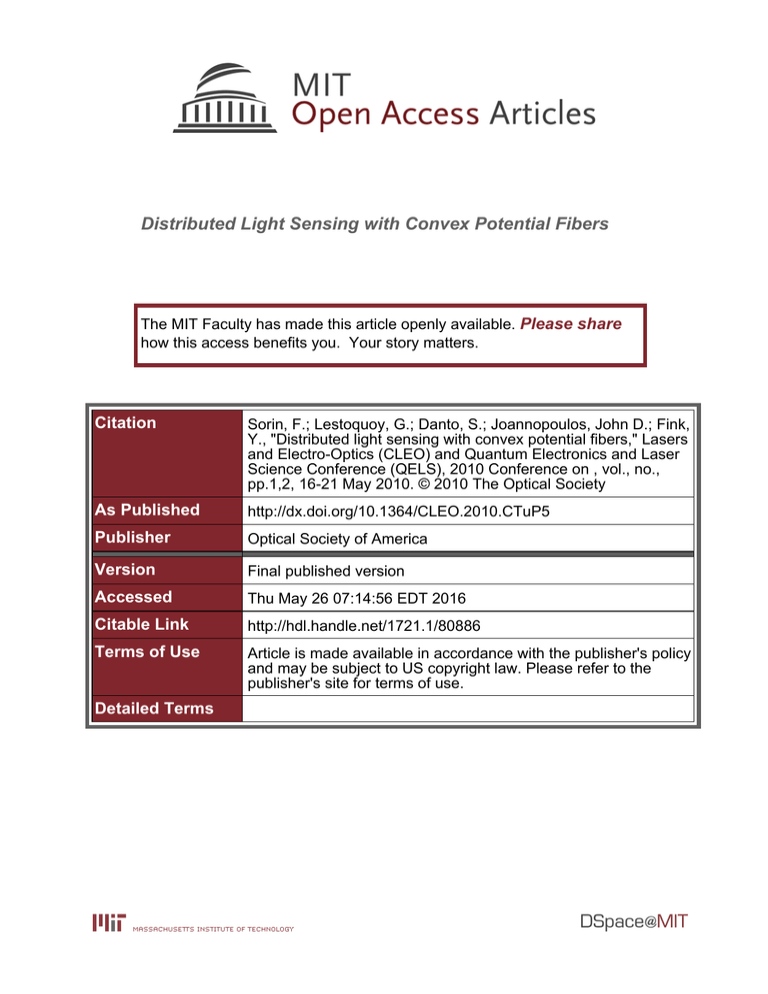Distributed Light Sensing with Convex Potential Fibers Please share
advertisement

Distributed Light Sensing with Convex Potential Fibers The MIT Faculty has made this article openly available. Please share how this access benefits you. Your story matters. Citation Sorin, F.; Lestoquoy, G.; Danto, S.; Joannopoulos, John D.; Fink, Y., "Distributed light sensing with convex potential fibers," Lasers and Electro-Optics (CLEO) and Quantum Electronics and Laser Science Conference (QELS), 2010 Conference on , vol., no., pp.1,2, 16-21 May 2010. © 2010 The Optical Society As Published http://dx.doi.org/10.1364/CLEO.2010.CTuP5 Publisher Optical Society of America Version Final published version Accessed Thu May 26 07:14:56 EDT 2016 Citable Link http://hdl.handle.net/1721.1/80886 Terms of Use Article is made available in accordance with the publisher's policy and may be subject to US copyright law. Please refer to the publisher's site for terms of use. Detailed Terms a2726_1.pdf CTuP5.pdf OSA / CLEO/QELS 2010 Distributed Light Sensing with Convex Potential Fibers Fabien Sorin1,2*, Guillaume Lestoquoy1* , Sylvain Danto2 , John D. Joannopoulos3,4 and Yoel Fink1,2 1 * Department of Materials Science and Engineering, 2Research Laboratory of Electronic, 3Institute for Soldier Nanotechnology 4Department of Physics, These authors participated equally to this work, Massachusetts Institute of Technology, Cambridge, MA 02139 Room 13-5078; e-mails: sorin@mit.edu Abstract: We report on a photoconductive fiber that supports decaying and convex electrical potential profiles capable of localizing a point of illumination, and propose a scheme to perform distributed optical sensing. © 2010 Optical Society of America OCIS codes: (160.2290) Fiber Materials; (040.5160) Photodetectors. Fibers present compelling opportunities for distributed sensing. The process of obtaining spatially resolved information is challenging and typically involves complex time domain measurements. Here we introduce an approach that enables distributed optical sensing in fibers without incurring the complexity associated with ultrafast detection schemes. We design and fabricate a fiber that supports, under particular boundary conditions, decaying and convex electrical potential profiles. This in turn allows us to localize a point of illumination with a spatial resolution that is close to 2 order of magnitude shorter than the fiber length, and to propose an approach to extract an arbitrary optical intensity distribution at a similar resolution. Fig. 1. A: Schematic of the thermal drawing process. B: Scanning Electron micrograph (SEM) of the cross section of the same fiber after thermal drawing. Close up on the interface between the glass core and the CPC electrode. C: Schematic of the fiber equivalent circuit. Thermal drawing is used to produce tens of meters of fibers as represented on Figure 1 [1-3]. These contain a photoconducting glass core contacted by a metal conductor on one side and a composite channel on the other. The metal used is a Tin-Lead eutectic composition while the composite comprises a carbon black filled Polycarbonate (CPC). The axial invariance of the fiber appears at first to preclude the derivation of axially dependent information. To break this symmetry an electrical bias is applied to the fiber as shown in Figure 1C. The differential equation that governs the change of potential V(z) along the fiber length in the steady state is given by: ∂ 2V V ( z ) ρ g ( z) π , with δ ( z ) = (1) = S cpc 2 2 ∂z δ ( z) ρ cpc 2 where ρg and ρCPC are the glass and CPC resistivities respectively, and SCPC is the cross section surface of the CPC electrode. The solution of this equation for an homogeneous system (δ independent of z) of length L, where the bias is applied at one fiber end only (V0 = 100 V and ∂VL/∂ z= 0 (no accumulation of charges)) is given by: 978-1-55752-890-2/10/$26.00 ©2010 IEEE a2726_1.pdf CTuP5.pdf OSA / CLEO/QELS 2010 Fig. 2. A: Theoretical curves of the voltage distribution along a fiber axis for different values of δ. B: Normalized dark current vs. fiber length. The curves are the theoretical values derive from the calculated voltage distribution while the dots are experimental results. C: Reconstruction of a beam position along the fiber lenght. Curve shows real experimental position while the dots are the reconstructed values. V ( z ) = V0 cosh (( L − z ) / δ ) / cosh(L / δ ) and is shown on Figure 2A for different decay lengths δ. This approach was tested experimentally by measuring the dark current versus fiber length (given by I dark / I dark ( L) = tanh(L / δ ) ) as shown on Figure 2B for the same δ values of Figure 2A. The agreement between theory and experiment is excellent. The use of equipotential metallic electrodes (for which δ>>L) has precluded us from breaking the fiber axial symmetry [1-3]. As δ gets smaller however, the voltage V(z0) at a location zo varies depending on which side of the fiber is biased. The free charges generated by a point of illumination at zo in the semiconducting glass will experience a different potential. Two photo-currents can hence be recorded, and their ratio associated to a unique position of the beam along the fiber axis (as long as the beam size is much smaller than the fiber length). The beam localization can therefore be reconstructed as shown on Figure 2C where sub-centimeter resolution was obtained over a half meter long fiber. If now we apply a bias at both fiber ends as depicted on Figure 3A, the potential is given by (still for a δ independent of z): V ( z ) = [V L sinh ( z / δ ) + V 0 sinh (( L − z ) / δ )] / sinh (L / δ ) as shown on Figure 3B, which is a convex function of z. This model is verified experimentally on Figure 3C. This approach enables to vary V0 and VL to obtain a large set of photo-currents from which more complex optical signals can be reconstructed. We will show however that in this scheme, the photo-currents aren’t independent and only provide limited information on the optical intensity to be reconstructed. We will then present an alternative strategy that uses two photconducting Fig. 3. A: Schematic of the convex potential scheme. At the potential minimum the current separates to reach one fiber end or the other B: Computed convex voltage profile along the fiber axis for V0 = 30 V and VL = 50 V. C: Current exiting one end of the fiber IL /V0 vs. VL /V0, glasses with different decay lengths. The convex potential distribution can be imposed by the glass of shorter δ and known at all time. The set of photocurrents recorded in the longer δ material together with the voltage profiles, form a Fredholm differential equation that can be used to extract the unknown optical field intensity along the fiber axis, with resolution of potentially 2 to 3 orders of magnitude smaller than the fiber length. This approach can have significant impact in applications such as large area optical and thermal sensing systems for industrial control and medical imaging, remote sensing and smart fabrics. [1] M. Bayindir, F. Sorin, et al., “Metal-insulator-semiconductor optoelectronic fibers”, Nature 431, 826- 829 (2004). [2] F. Sorin, et al., “Multimaterial Photodetecting fibers: a geometric and structural study”, Advanced Materials 19, 3872–3877 (2007). [3] F. Sorin, et al, “Exploiting the collective effects of optoelectronic devices integrated in a single fiber” NanoLetters , 9 (7), 2630–2635 (2009).








